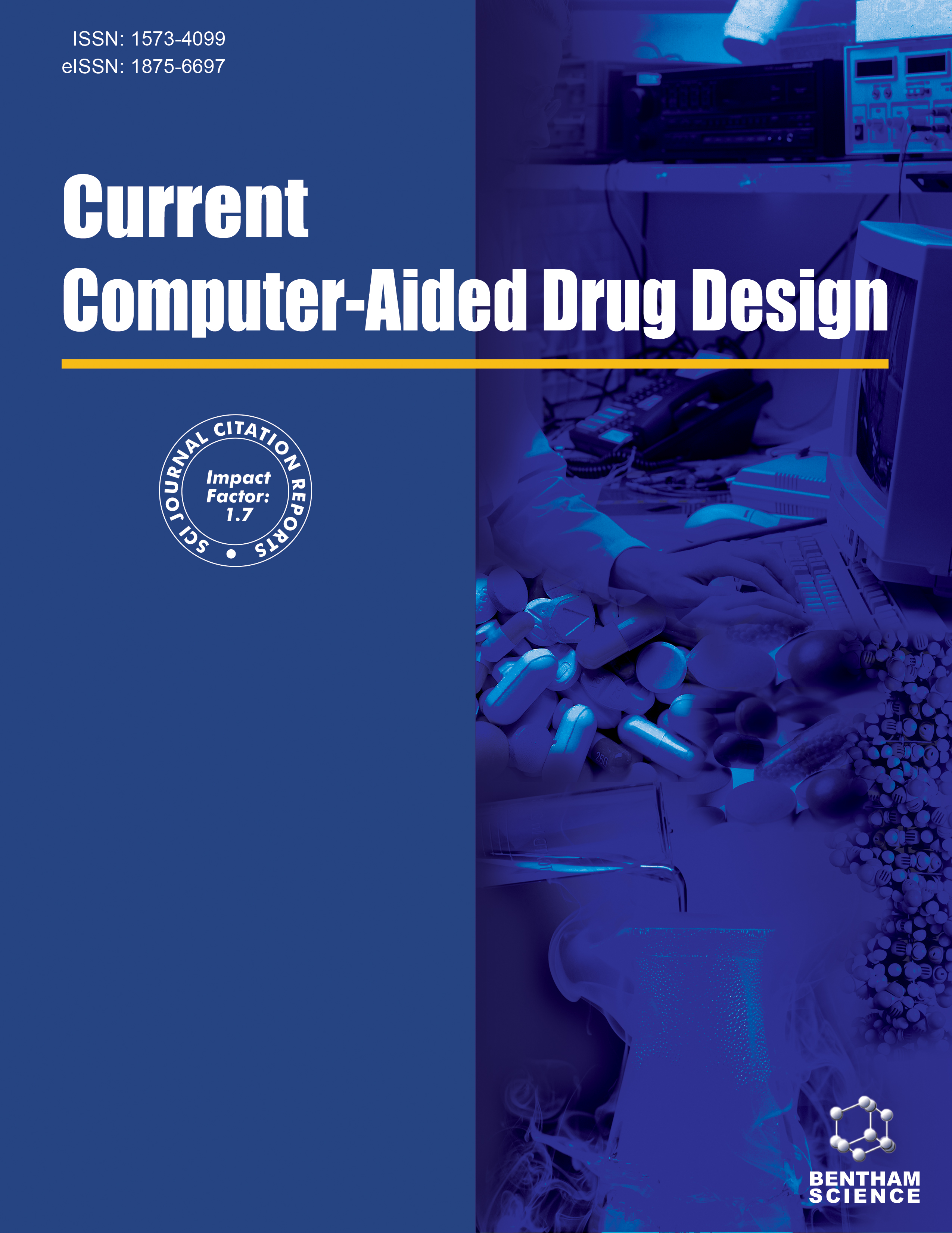- Home
- A-Z Publications
- Current Computer - Aided Drug Design
- Previous Issues
- Volume 20, Issue 2, 2024
Current Computer - Aided Drug Design - Volume 20, Issue 2, 2024
Volume 20, Issue 2, 2024
-
-
Prediction of the Molecular Mechanism of Corni Fructus-Epimedii Folium- Rehmanniae Radix Praeparata in the Treatment of Postmenopausal Osteoporosis based on Network Pharmacology and Molecular Docking
More LessAuthors: Yu Zhou, Xin Li, Jinchao Wang, Rong He, Liqi Ng, Dapeng Li, Jeremy Mortimer, Swastina Nath Varma, Jinhua Hu, Qing Zhao, Zeyu Peng, Chaozong Liu and Songchuan SuIntroduction: In this study, core drugs of clinical postmenopausal osteoporosis were retrieved using data mining, the drug molecular action target was predicted through network pharmacology, the key nodes of interaction were identified by combining postmenopausal osteoporosis-related targets, and the pharmacological mechanism of Traditional Chinese Medicine (TCM) against postmenopausal osteoporosis and other acti Read More
-
-
-
Network Pharmacology and Intestinal Microbiota Analysis Revealing the Mechanism of Punicalagin Improving Bacterial Enteritis
More LessAuthors: Shuyun Huang, Ying Wang, Qingsong Zhu, Hongmin Guo, Zongyuan Hong and Shuzhi ZhongBackground: The Chinese medicine punicalagin (Pun), the most important active ingredient in pomegranate peel, has significant bacteriostatic and anti-inflammatory properties. The potential mechanisms of Pun for bacterial enteritis, however, are unknown. Objective: The goal of our research is to investigate the mechanism of Pun in the treatment of bacterial enteritis using computer-aided drug technology, as well as to investiga Read More
-
-
-
The Possibility of Polygonum cuspidatum against Osteoarthritis based on Network Pharmacology
More LessAuthors: Chengyin Liu, Lingyun Yu, Yixin Jiang, Songlian Gu, Chenjian Li, Wen Yin and Zhenlei ZhouBackground: Polygonum cuspidatum (PC), a widely used Chinese herbal medicine (CHM), plays an important role in treating various diseases including osteoarthritis (OA). Yet, the multicomponent and multitarget characteristics of PC make deciphering the pharmacological mechanisms difficult. Objective: The purpose of this study is to identify the core molecular mechanisms of PC against OA. Methods: The Traditional Ch Read More
-
-
-
Screening of Inhibitors against Idiopathic Pulmonary Fibrosis: Few-shot Machine Learning and Molecule Docking based Drug Repurposing
More LessAuthors: Jun Chang, Shaoqing Zou, Subo Xu, Yiwen Xiao and Du ZhuIntroduction: Idiopathic pulmonary fibrosis is a chronic progressive disorder and is diagnosed as post-COVID fibrosis. Idiopathic pulmonary fibrosis has no effective treatment because of the low therapeutic effects and side effects of currently available drugs. Aim: The aim is to screen new inhibitors against idiopathic pulmonary fibrosis from traditional Chinese medicines. Methods: Few-shot-based machine learning and mole Read More
-
-
-
In vitro Culture and Multilocus Genotyping of Giardia duodenalis Trophozoites Obtained from Human Fecal Samples in Southwest of Iran
More LessAuthors: Hossein Ali Yousefi, Fatemeh Asgarian, Mehdi Tavalla, Shokouh Ghafari and Kobra KohansalIntroduction: The enteric protozoa, Giardia duodenalis (G. duodenalis), consists of eight distinct assemblages (A-H) with identical morphological characteristics and a direct life cycle. Successful axenic cultivation of this parasite is an important preliminary step for biological, drug resistance and phylogenetic studies. Moreover, G. duodenalis exhibits great genetic and biotypic diversity. Aim: The current study aimed to evaluat Read More
-
-
-
Esters of Quinoxaline-7-Carboxylate 1,4-di-N-Oxide as Potential Inhibitors of Glycolytic Enzymes of Entamoeba histolytica: In silico Approach
More LessBackground: Esters of quinoxaline-7-carboxylate 1,4-di-N-oxide (7-carboxylate QdNOs) derivatives are compounds that inhibit the growth of Entamoeba histolytica, the causative agent of amebiasis. Although these compounds cause changes in the redistribution of glycogen deposits within the parasite, it is unknown whether these compounds interact with enzymes of the glycolytic pathway. Objective: The aim of this s Read More
-
-
-
Exploring the Molecular Mechanism of HongTeng Decoction against Inflammation based on Network Analysis and Experiments Validation
More LessAuthors: Yuanyuan Yang, Chongwen Bi, Bin Li, Yun Li, Yin Song, Minghui Zhang, Longxi Peng, Dongmei Fan, Rong Duan and Zhengxiang LiBackground: HongTeng Decoction (HTD) is a traditional Chinese medicine that is widely used to treat bacterial infections and chronic inflammation. However, its pharmacological mechanism is not clear. Here, network pharmacology and experimental verification were applied to investigate the drug targets and potential mechanisms of HTD in inflammation treatment. Methods: The active ingredients of HTD were collected from t Read More
-
-
-
Application of Network Pharmacology and Molecular Docking to Explore the Mechanism of Danggui Liuhuang Tang against Hyperthyroidism
More LessAuthors: Dan Song, Bin Yang, Wenzheng Bao and Jinglong WangIntroduction: To investigate the mechanism of Danggui Liuhuang Tang (DGLHT) in the treatment of hyperthyroidism (HT), we explored the multi-component, multi-target, and multi-pathway mechanism based on the network pharmacology method of traditional Chinese medicine. Objective: Using network pharmacology and molecular docking, the effective components, core targets, and critical pathways of DGLHT in the ther Read More
-
Volumes & issues
-
Volume 21 (2025)
-
Volume 20 (2024)
-
Volume 19 (2023)
-
Volume 18 (2022)
-
Volume 17 (2021)
-
Volume 16 (2020)
-
Volume 15 (2019)
-
Volume 14 (2018)
-
Volume 13 (2017)
-
Volume 12 (2016)
-
Volume 11 (2015)
-
Volume 10 (2014)
-
Volume 9 (2013)
-
Volume 8 (2012)
-
Volume 7 (2011)
-
Volume 6 (2010)
-
Volume 5 (2009)
-
Volume 4 (2008)
-
Volume 3 (2007)
-
Volume 2 (2006)
-
Volume 1 (2005)
Most Read This Month
Article
content/journals/cad
Journal
10
5
false
en


